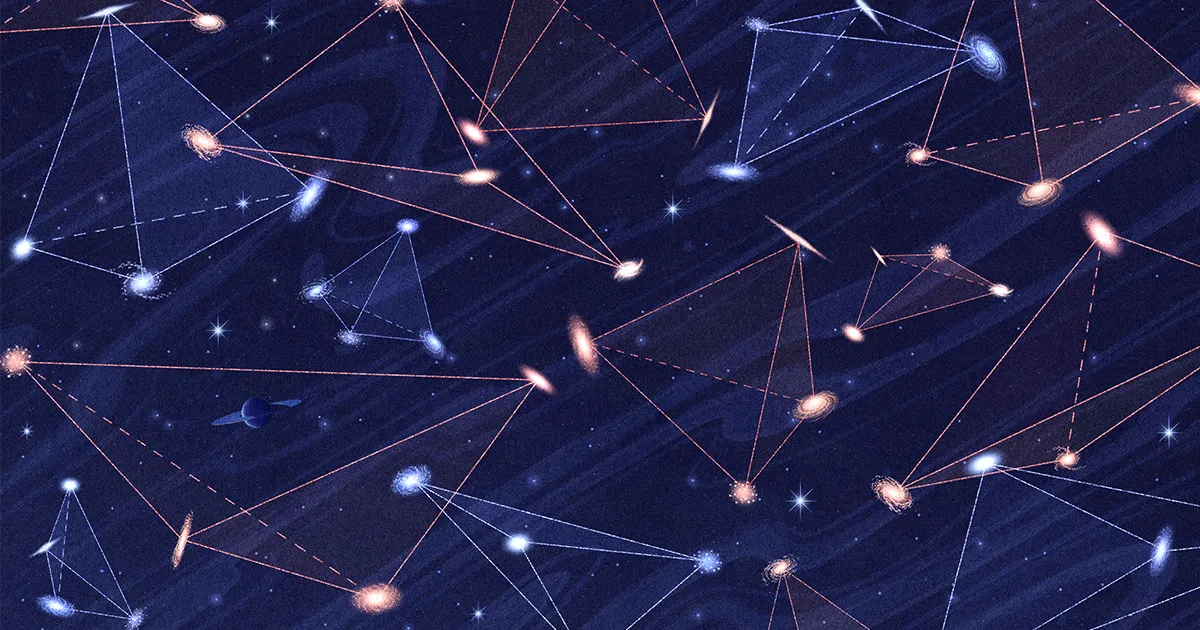Physicists believe they have detected a striking asymmetry in the arrangements of galaxies in the sky. If confirmed, the finding would point to features of the unknown fundamental laws that operated during the Big Bang.
“If this result is real, someone’s going to get a Nobel Prize,” said Marc Kamionkowski, a physicist at Johns Hopkins University who was not involved in the analysis.
As if playing a cosmic game of Connect the Dots, the researchers drew lines between sets of four galaxies, constructing four-cornered shapes called tetrahedra. When they had built every possible tetrahedron from a catalog of 1 million galaxies, they found that tetrahedra oriented one way outnumber their mirror images.
A hint of the imbalance between tetrahedra and their mirror images was first reported by Oliver Philcox, an astrophysicist at Columbia University in New York, in a paper published in Physical Review D in September. In an independent analysis conducted simultaneously that’s now undergoing peer review, Jiamin Hou and Zachary Slepian of the University of Florida and Robert Cahn of Lawrence Berkeley National Laboratory detected the asymmetry with a level of statistical certainty that physicists usually consider definitive.
But with such a blockbuster finding — and one that’s still under review — experts say caution is warranted.
“There’s no obvious reason that they’ve made a mistake,” said Shaun Hotchkiss, a cosmologist at the University of Auckland. “That doesn’t mean that there isn’t a mistake.”
The putative imbalance violates a symmetry called “parity,” an equivalence of left and right. If the observation withstands scrutiny, physicists think it must reflect an unknown, parity-violating ingredient in the primordial process that sowed the seeds of all the structure that developed in our universe.
“It’s an incredible result — really impressive,” Kamionkowski said. “Do I believe it? I’m going to wait to really celebrate.”
Left-Handed Universe
Parity was once a cherished symmetry of physics. But then, in 1957, the Chinese American physicist Chien-Shiung Wu’s nuclear decay experiments revealed that our universe indeed has a slight handedness to it: Subatomic particles involved in the weak nuclear force, which causes nuclear decay, are always magnetically oriented in the opposite direction from the one they move in, so that they spiral like the threads of a left-handed screw. The mirror-image particles — the ones like right-handed screws — don’t feel the weak force.
Wu’s revelation was shocking. “We are all rather shaken by the death of our well-beloved friend, parity,” the physicist John Blatt wrote in a letter to Wolfgang Pauli.
The left-handedness of the weak force has subtle effects that couldn’t have influenced the cosmos on galactic scales. But ever since Wu’s discovery, physicists have sought other ways in which the universe differs from its mirror image.
If, for instance, some primordial parity violation was in effect when the universe was in its infancy, it might have imprinted a twist onto the structure of the cosmos.
At or near the time of the universe’s birth, a field known as the inflaton is thought to have permeated space. A roiling, boiling medium where inflaton particles continuously bubbled up and disappeared, the inflaton field was also repulsive; for the brief time it may have existed, it would have caused our universe to rapidly expand to 100 trillion trillion times its original size. All of those quantum fluctuations of particles in the inflaton field were flung outward and frozen into the cosmos, becoming variations in the density of matter. The denser pockets continued to gravitationally coalesce to produce the galaxies and large-scale structure we see today.
In 1999, researchers including Kamionkowski considered what would happen if more than one field was present before this explosion. The inflaton field could have interacted with another field that could produce right-handed and left-handed particles. If the inflaton treated right-handed particles differently than the left-handed ones, then it could have preferentially created particles of one handedness over the other. This so-called Chern-Simons coupling would have imbued the early quantum fluctuations with a preferred handedness, which would have evolved into an imbalance of left-handed and right-handed tetrahedral arrangements of galaxies.
As for what the additional field might be, one possibility is the gravitational field. In this scenario, a parity-violating Chern-Simons interaction would occur between inflaton particles and gravitons — the quantum units of gravity — which would have popped up in the gravitational field during inflation. Such an interaction would have created a handedness in the density variations of the early universe and, consequently, in today’s large-scale structure.





















